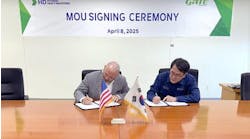Complex of pipelines in prospect to add to Bach Ho utilisation
- Vietsovpetro's Bach Ho lies in Block 09.
- Table: Vietnamese gas production forecast - 1995-2002 (mcf/d)
Visions of Vietnam as the new oil province have given way to blueprints of LPG terminals, as the government takes stock of its resources.
A clutch of gas finds in the Nam Con Son Basin last year will have raised eyebrows amongst Vietnam's energy-thirsty neighbours. Ho Si Thoang, head of state oil concern PetroVietnam, was moved to predict that by 2000, his nation could be producing 4-5 bcm/yr.
This would be a rapid turnaround for a country that until recently was flaring away most of its produced offshore gas, and where serious storage and pipeline infrastructure are only now falling into place.
Bach Ho collects
To date, the most publicized concerted activity has centered on Vietnam's main producing oilfield, Bach Ho, where gas has hitherto been burned off at the rate of around 3 million cm/d. Last year, Vietsovpetro began constructing a gas collection system in the field, which included an access bridge to the No. 2 central production platforms, and also expansion of that platform.
Hyundai of Korea used laybarge HD2500 to install a 16-in. dia. pipeline from the field which stretches 107 km to Long Hai on the coast, then nearly 20 km overland to a power plant in Ba Ria. Here further gas turbines will be installed in 1996-97 with combined capacity of 95MW.
Simultaneously with last year's pipelaying, an international consortium of British Gas, Mitsui, PetroVietnam, and TransCanada Pipelines (the latter has since dropped out) performed a feasibility study for Bach Ho gas known as the Vietnam Gas Utilization Project.
The aim of this project is to extract LNG from Bach Ho's associated gas, then use the remaining lean gas for power generation, with the three companies managing the operation under a joint venture. Gas export would start in 1996, with annual gas production of perhaps 300,000 tons going mainly to countries in Southeast Asia.
Assuming approval has come from the Vietnamese government, work should already be under way on setting up an offshore gas compression system on Bach Ho with a capacity of 3 bcm/yr. Half will be kept by Vietsovpetro for its platform production programme, with the rest heading ashore via the pipeline.
Also planned are an 85 km onshore pipeline to take gas from Ba Ria to Ho Chi Minh City; a new LPG production plant near Vung Tau; and an LPG port and storage terminal. Overall, work on the gas utilization project is estimated to cost $400 million.
Pooled development
Last spring, Vietnam's Energy Ministry estimated that gas output from Bach Ho and the onshore Tien Hai fields could reach 300 bcm. This was before the confirmation in the autumn of further finds in BP/Statoil's Block 6, Lasmo's 4.2 and later, Total's 11.1 - all close together in the Nam Con Son Basin.
Following these discoveries, Nguyen Trong Hanh, PetroVietnam's director of project evaluation, forecast that the basin should be able to export 500-800 mcf/d in the not too distant future, mainly to Thailand. But for Vietnam really to cash in on gas sales to Japan, Korea and Taiwan, spare reserves of 6-8 tcf would be needed to construct the necessary LNG plant, Hanh pointed out.
There is also the little matter of funding such facilities. These gas-guzzling nations might want evidence of guaranteed deliveries before stumping up the cash for construction.
There has been conjecture about tying in the various finds, plus gas from BHP's Dai Hung Field, into a new pipeline to Vung Tau. But although it would make sense for the block operators to pool resources, there is first a fair amount of testing and appraisal work to be done on the accumulations. Lasmo's initial discovery, for instance, is not considered commercial.
Vietnam lacks a state corporation dedicated to planning gas infrastructure, although the gas utilization project may throw up some suggestions on the way forward. A spanner in the works, however, could be the nearness of Block 6 to the South China Sea waters which China is claiming entirely for itself.
Copyright 1995 Offshore. All Rights Reserved.


